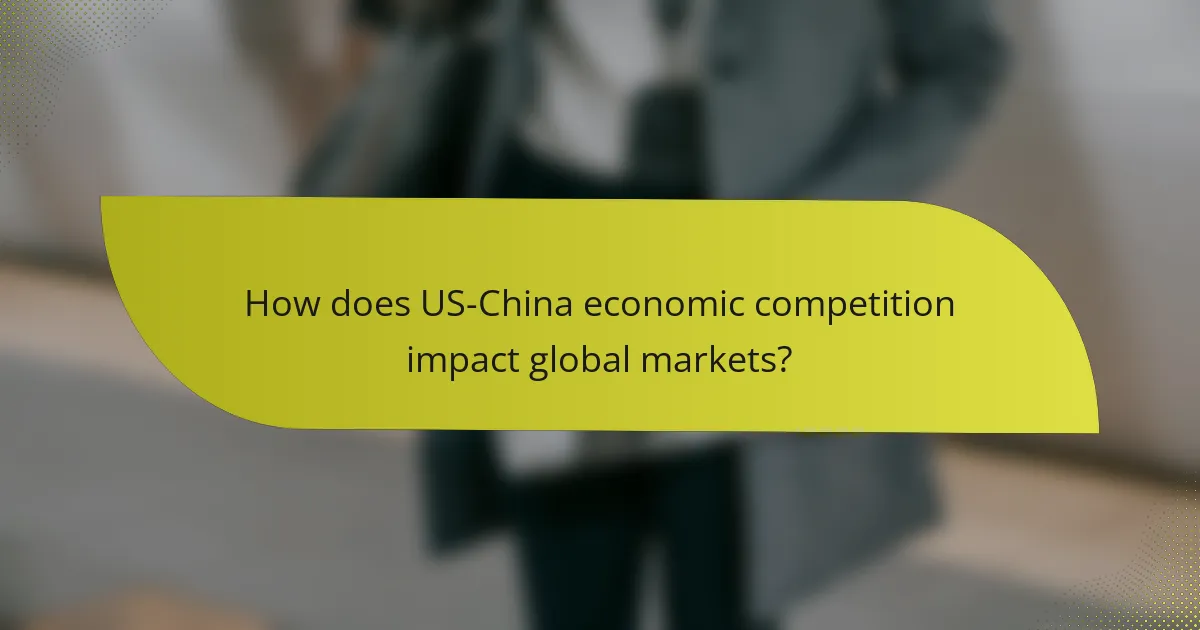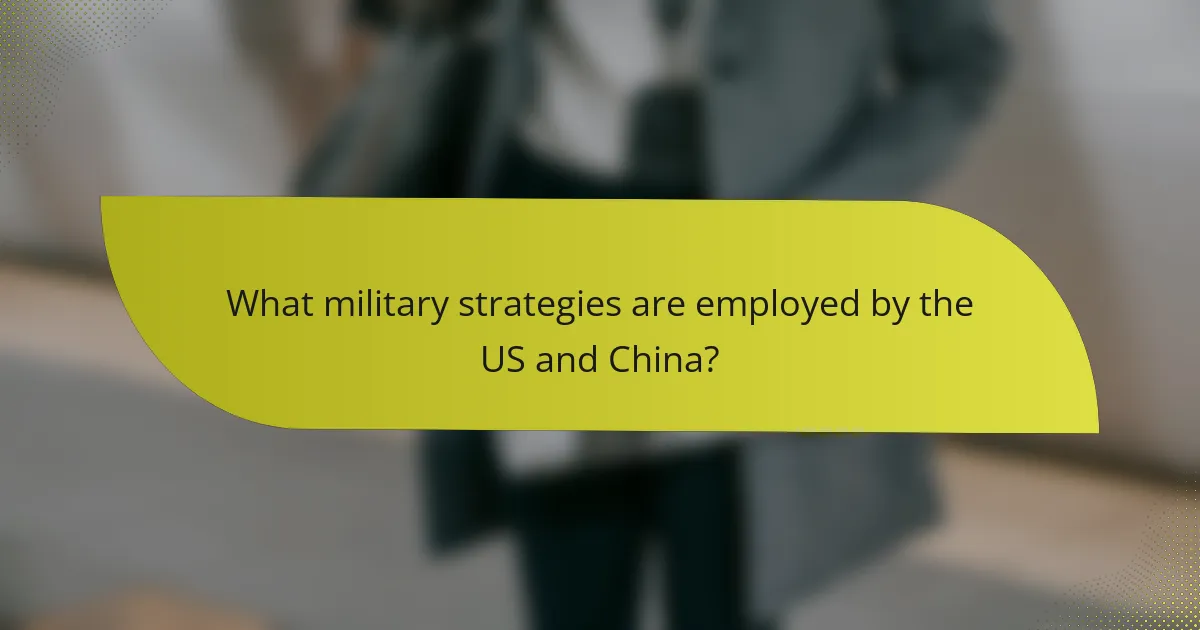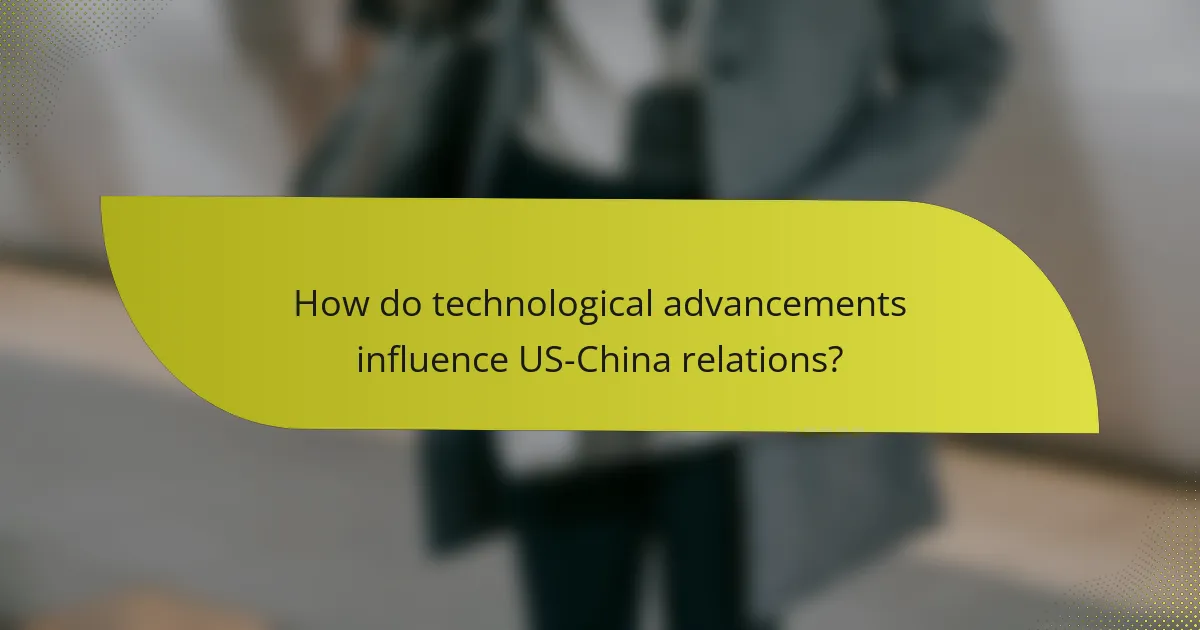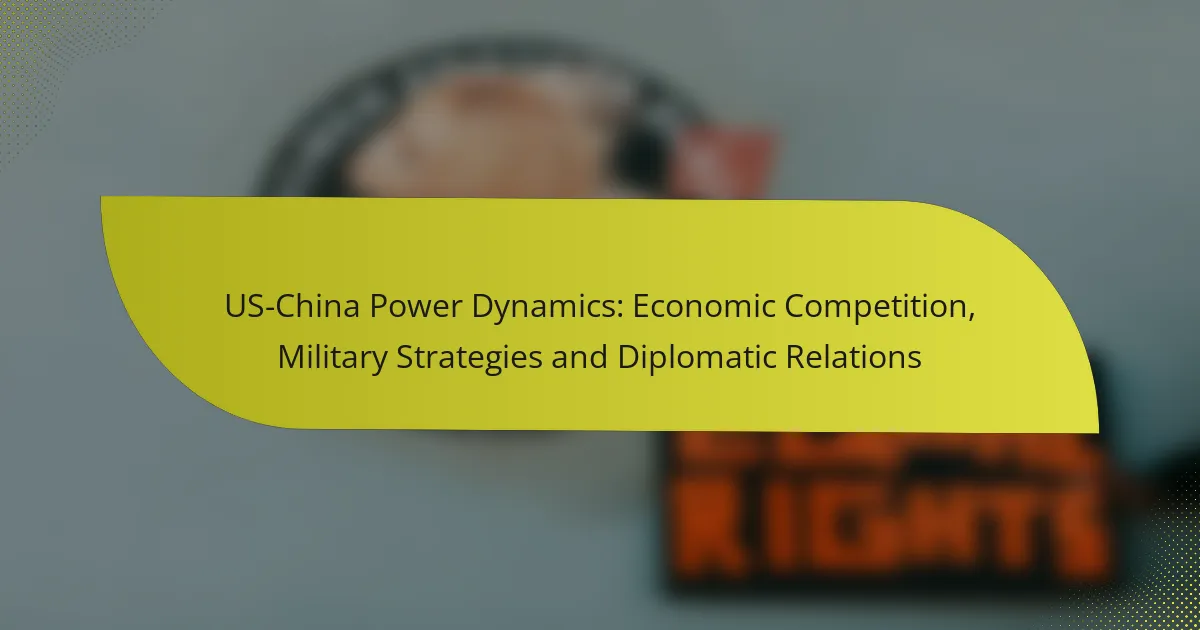The power dynamics between the US and China are characterized by intense economic competition, military strategies, and complex diplomatic relations. As these two nations vie for global influence, their actions shape international trade, security, and cooperation, impacting markets and geopolitical stability worldwide. Understanding this multifaceted relationship is crucial for grasping the future of global affairs.

How does US-China economic competition impact global markets?
The economic competition between the US and China significantly influences global markets by affecting trade flows, investment patterns, and supply chain dynamics. As these two economic giants engage in competition, their policies and strategies can lead to volatility and shifts in market behavior worldwide.
Trade tariffs and their effects
Trade tariffs imposed by the US and China create barriers that alter the cost of goods and services between the two nations. For instance, higher tariffs on Chinese imports can lead to increased prices for American consumers, while Chinese retaliatory tariffs can affect US exporters. This back-and-forth can disrupt global trade relationships and lead to increased uncertainty in markets.
Businesses must navigate these tariffs by adjusting pricing strategies or seeking alternative suppliers. Companies that rely heavily on imports from either country may need to reassess their supply chains to mitigate the financial impact of tariffs.
Investment shifts in technology sectors
The US-China economic rivalry has prompted significant investment shifts, particularly in technology sectors. Both nations are investing heavily in emerging technologies like artificial intelligence, semiconductors, and 5G networks, aiming to secure a competitive edge. This race for technological supremacy can lead to increased funding for domestic companies and startups.
Investors should be aware of the potential for rapid changes in funding landscapes and consider diversifying their portfolios to include companies that are positioned to benefit from these shifts. Monitoring government policies and incentives in both countries can provide insights into future investment opportunities.
Impact on supply chains
The economic competition between the US and China has a profound impact on global supply chains, prompting companies to rethink their sourcing strategies. Many businesses are diversifying their supply chains to reduce dependence on either country, which can lead to increased costs and longer lead times. For example, companies might explore manufacturing in Southeast Asia or other regions as alternatives.
To effectively manage supply chain risks, companies should conduct thorough assessments of their current suppliers and consider building relationships with multiple sources. This proactive approach can help mitigate disruptions caused by geopolitical tensions and trade policies.

What military strategies are employed by the US and China?
The military strategies of the US and China focus on deterrence, power projection, and regional influence. Both nations employ a combination of advanced technology, strategic alliances, and military presence to assert their interests in Asia and beyond.
US military presence in Asia
The US maintains a significant military presence in Asia, with bases in countries like Japan, South Korea, and Guam. This presence serves as a deterrent against potential aggression and reassures allies of American commitment to regional security.
Key components of the US strategy include joint military exercises, naval deployments, and the use of advanced military technology such as aircraft carriers and missile defense systems. These assets enhance the US’s ability to respond quickly to threats in the region.
China’s military modernization efforts
China is actively modernizing its military capabilities to enhance its regional and global influence. This includes investments in advanced technologies such as cyber warfare, artificial intelligence, and missile systems.
The Chinese government has focused on expanding its naval forces, particularly through the construction of aircraft carriers and submarines, to project power in the South China Sea and beyond. This modernization aims to challenge US dominance and assert China’s territorial claims.
Regional security alliances
Regional security alliances play a crucial role in the military strategies of both the US and China. The US has established alliances such as the Quad (with Japan, India, and Australia) and maintains strong ties with NATO partners to counterbalance China’s influence.
China, on the other hand, seeks to strengthen its relationships with countries in Asia and beyond through initiatives like the Belt and Road Initiative, which aims to create economic and military partnerships. These alliances shape the strategic landscape and influence military postures in the region.

How do US-China diplomatic relations shape international policy?
The diplomatic relations between the US and China significantly influence international policy by setting the tone for global cooperation and competition. Their interactions often dictate responses to global challenges, trade agreements, and security arrangements among other nations.
Key diplomatic agreements
Key agreements between the US and China, such as the Joint Comprehensive Plan of Action (JCPOA) regarding Iran’s nuclear program and the Paris Agreement on climate change, illustrate their collaborative efforts. These agreements often serve as frameworks for addressing broader international issues, impacting how other countries align their policies.
Additionally, trade agreements like the Phase One trade deal highlight the economic dimensions of their diplomatic relations. Such agreements can lead to shifts in global supply chains and trade practices, affecting economies worldwide.
Influence on global governance
The US and China play pivotal roles in global governance through institutions like the United Nations and the World Trade Organization. Their diplomatic relations can either strengthen or undermine multilateral efforts, depending on their alignment or divergence on key issues.
For instance, their differing approaches to climate change and human rights can create rifts that challenge collective action. Countries often find themselves navigating these dynamics, adjusting their policies based on the prevailing US-China relationship.
Responses to international crises
During international crises, the US-China diplomatic relationship can dictate the effectiveness of global responses. For example, their cooperation or conflict during health emergencies, such as the COVID-19 pandemic, has significant implications for global health governance.
Moreover, their stances on regional conflicts, such as those in the South China Sea or Taiwan, can escalate tensions or foster diplomatic resolutions. Countries must consider these dynamics when formulating their own foreign policies in response to crises.

What are the implications of US-China power dynamics for other nations?
The power dynamics between the US and China significantly influence global relations, affecting trade, security, and diplomatic strategies of other nations. Countries must navigate these tensions to protect their interests and foster beneficial partnerships.
Responses from European Union
The European Union (EU) is increasingly aware of the need to balance its economic ties with China while maintaining a strong alliance with the US. This has led to a more cautious approach towards Chinese investments, particularly in critical infrastructure and technology sectors.
In response to US-China tensions, the EU has sought to enhance its strategic autonomy, focusing on developing its defense capabilities and fostering closer ties with like-minded partners. Initiatives like the EU’s Global Gateway aim to counterbalance China’s Belt and Road Initiative by investing in sustainable infrastructure globally.
Impact on ASEAN countries
ASEAN countries face unique challenges due to their geographical proximity to both the US and China. Many nations in this region are striving to maintain neutrality while benefiting from economic opportunities presented by both powers.
Trade agreements and regional partnerships, such as the Regional Comprehensive Economic Partnership (RCEP), are crucial for ASEAN nations to enhance economic resilience. However, they must also navigate security concerns, particularly in the South China Sea, where territorial disputes with China are prevalent.
Emerging alliances in Africa
Africa is witnessing a shift in alliances as countries respond to US-China power dynamics. China’s significant investments in infrastructure and resources have led to stronger ties with many African nations, while the US is working to counterbalance this influence through initiatives focused on democracy and economic development.
Emerging alliances may prioritize economic cooperation over military partnerships, as African nations seek to leverage investments from both the US and China. Countries like Kenya and Nigeria are balancing these relationships to maximize benefits while minimizing dependency on either power.

How do technological advancements influence US-China relations?
Technological advancements significantly impact US-China relations by shaping economic competition, military strategies, and diplomatic interactions. Innovations in key areas like telecommunications and artificial intelligence create both opportunities for collaboration and tensions over security and dominance.
5G technology competition
The competition in 5G technology exemplifies the broader technological rivalry between the US and China. Both nations aim to lead in the deployment of this advanced telecommunications infrastructure, which is crucial for enhancing connectivity and enabling innovations like smart cities and autonomous vehicles.
The US has raised concerns about security risks associated with Chinese companies like Huawei, citing potential espionage and data privacy issues. In contrast, China promotes its 5G capabilities as essential for economic growth and technological independence, pushing for global adoption of its standards.
Artificial intelligence race
The race for leadership in artificial intelligence (AI) is a critical aspect of US-China relations, with both countries investing heavily in research and development. The US focuses on fostering innovation through private sector initiatives, while China leverages state support to accelerate its AI advancements.
AI applications range from healthcare to military uses, making this competition not just about technology but also about national security and economic power. Both nations are developing strategies to attract talent and funding, with China aiming to become the global leader in AI by the 2030s.
Cybersecurity threats
Cybersecurity threats are a significant concern in the context of US-China technological advancements. Both countries accuse each other of cyber espionage and attacks, which complicates diplomatic relations and raises tensions in the tech sector.
As both nations enhance their cyber capabilities, they must also address vulnerabilities in their infrastructures. Companies operating in either country should prioritize robust cybersecurity measures and stay informed about evolving threats to protect sensitive data and maintain trust with consumers and partners.

What are the future trends in US-China power dynamics?
The future trends in US-China power dynamics will likely be characterized by a mix of competition and potential collaboration across various sectors. As both nations navigate their economic and military strategies, their diplomatic relations will play a crucial role in shaping global stability and influence.
Potential for cooperation
Despite ongoing tensions, there remains significant potential for cooperation between the US and China in areas such as climate change, public health, and trade. Collaborative efforts in these domains can lead to mutual benefits, fostering a more stable international environment.
For instance, joint initiatives on renewable energy technologies could enhance both countries’ economic prospects while addressing global environmental challenges. Establishing communication channels to discuss shared interests is essential for mitigating conflicts and promoting collaboration.
Long-term economic forecasts
Long-term economic forecasts suggest that the US and China will continue to be major players in the global economy, but their competition may intensify. Analysts predict that China’s GDP growth may gradually slow, while the US economy could see moderate growth driven by innovation and technology.
Trade relations will be influenced by tariffs, regulations, and supply chain dynamics. Businesses should stay informed about potential shifts in trade policies and adapt their strategies accordingly to navigate this evolving landscape effectively.
